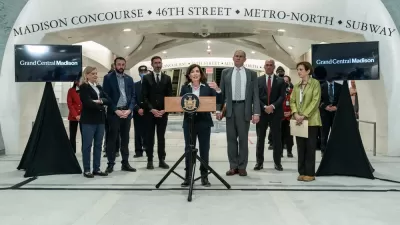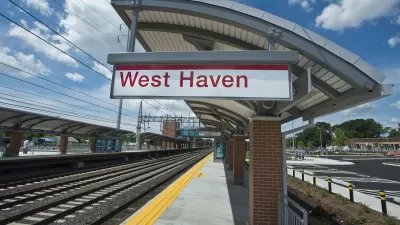While MTA’s East Side Access project, which will bring Long Island Rail Road (LIRR) trains directly to Grand Central Terminal by 2019, has received much attention, less well-know is a complementary plan to bring Metro-North trains to Penn Station.
To be sure, Penn Station Access is in the study phase while it's East Side counterpart, one of the nation's most expensive New Starts projects, is under construction. However, the plan, that includes adding four new stops to Bronx neighborhoods, two on Manhattan's west side, and "would bring six to 10 Metro-North trains into Penn Station during rush hour" has Long Island legislators worried that "the plan could mean a reduction in service for the LIRR at Penn Station". Wilder Fleming reports on the rationale for the new project, where the funding may be found, and the apparent conflict with LIRR service.
Bronx politicians are pushing hard for the so-called Penn Station Access plan. They hope that a new commuter line would stimulate commerce in and around the neighborhoods of Hunts Point, Morris Park, Parkchester and Co-op City.
New York City's Department of City Planning has initiated the Sustainable Communities: Bronx Metro - North Study that "proposes to study multiple existing Metro-North stations in the Bronx along with proposed stations which are part of the plan to bring Metro-North to Penn Station".
Funding may have been found "in a $5.67 billion proposal for disaster mitigation, which the MTA expects will be “predominantly funded through reimbursements obtained from the federal government (including the Federal Transit Administration [FTA] and the Federal Emergency Management Agency [FEMA]).” Rationale for tapping these funds stems from the fact that Metro-North has only one access point into Manhattan [Grand Central Terminal].
In the wake of Superstorm Sandy, the MTA has come to view single points of failure affecting entire transit systems as unacceptable; creating and maintaining multiple access points has become part and parcel of their strategy to defend against future disasters.
The cost would pale in comparison to the "$8 billion-plus East Side Access plan". It was "estimated at $1.2 billion in a 2008–13 Capital Plan report from Comptroller Thomas DiNapoli’s office".
At stake are 37 rush-hour train slots at Penn Station. It was expected that the East Side Access project would reduce service to Penn Station, but LIRR is predicting a growth in service, so it appears they are unwilling to allow Metro-North to use those platforms, regardless of the diversion of trains from Penn Station to Grand Central Terminal.
FULL STORY: All Aboard? LI Lawmakers Worry as MTA Eyes New Bronx Commuter Rail Stations

Study: Maui’s Plan to Convert Vacation Rentals to Long-Term Housing Could Cause Nearly $1 Billion Economic Loss
The plan would reduce visitor accommodation by 25,% resulting in 1,900 jobs lost.

Alabama: Trump Terminates Settlements for Black Communities Harmed By Raw Sewage
Trump deemed the landmark civil rights agreement “illegal DEI and environmental justice policy.”

North Texas Transit Leaders Tout Benefits of TOD for Growing Region
At a summit focused on transit-oriented development, policymakers discussed how North Texas’ expanded light rail system can serve as a tool for economic growth.

Los Angeles County Invests in Wildfire Recovery for Parks, Trails, and Open Space
The $4.25 million RESTORE Program supports the recovery of parks, trails, and open spaces damaged by the January 2025 wildfires through targeted grants that promote community healing, wildfire resilience, and equitable access to nature.

Nevada Bills Aim to Establish Home Insurance Assurance Amidst Wildfire Risk
Republican sponsor hopes the FAIR plan would be “a true market of last resort.”

Virginia Law Allows Judges to Mandate Speed Limiters
The law could set a new precedent for speed limiting tech on U.S. vehicles.
Urban Design for Planners 1: Software Tools
This six-course series explores essential urban design concepts using open source software and equips planners with the tools they need to participate fully in the urban design process.
Planning for Universal Design
Learn the tools for implementing Universal Design in planning regulations.
City of Santa Clarita
Ascent Environmental
Institute for Housing and Urban Development Studies (IHS)
City of Grandview
Harvard GSD Executive Education
Toledo-Lucas County Plan Commissions
Salt Lake City
NYU Wagner Graduate School of Public Service




























